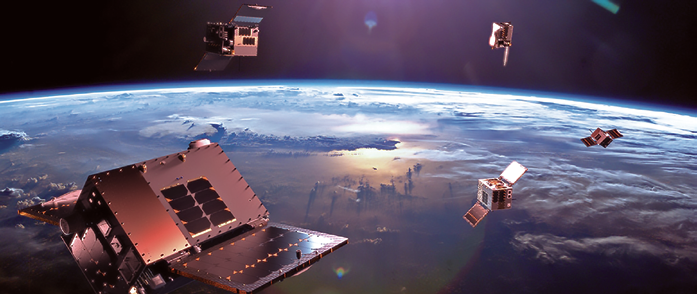The electromagnetic spectrum is in use all around us. One part of the spectrum — radio frequency (RF) — is used to power communications, navigation and other operations.
Despite their ubiquity, RF signals have traditionally been difficult to locate and visualize without expensive, time-consuming, on-site processes. At HawkEye 360, we realized that if we made RF signal geolocation more accessible, we could reveal an entirely new layer of data and intelligently report on this important resource.

That’s the mission that we set out to pursue when we founded HawkEye 360 in 2015. Today, we’re the first commercial company to use formation flying satellites to create a new class of RF analytics. We use precise mapping of RF emissions to help clients in maritime, crisis response, government, defense, and telecommunications gain new insights and make more informed decisions. Developing a solution for precise RF spectrum mapping required us to rethink traditional approaches in the satellite industry. In fact, in designing our solutions, we had to employ cutting-edge innovations to overcome three key technological and business challenges.
Challenge 1: Overcoming the Space Entry Barriers
Traditionally, RF signal analysis requires a team of experts to trek to a remote location with expensive ground equipment, like all terrain vehicles with roll-on/roll-off equipment or man-portable installations. Analysis can take days to weeks—or even longer if the signal origin is unclear. In a maritime use case, such as searching for ships participating in illegal fishing, this pace would make RF analysis ineffective—vessels would be long gone by the time analysis was complete.
Identifying RF signals from space was a clear answer to timely RF analysis and geolocation. However, it wasn’t going to be feasible on a start-up budget for us to develop and launch a solution based on traditional satellites. This was the first major challenge we had to overcome.
Ultimately, we decided to employ smallsats, as they would allow for rapid deployment at a reasonable cost. We found that the ecosystem of small satellite providers had reached maturity, enabling development of very sophisticated technical solutions. Plus, the price point was important, as we want to keep our services accessible to a wide range of customers. Employing smallsats helped us significantly reduce the cost of both the hardware and launch, compared to traditional satellites. Smallsats also will allow us to quickly build out a larger constellation for more effective coverage.
As a result, we have been able to offer clients reliable data from the first cluster we launched in December o 2018, which became fully operational in February of 2019. We are also in the process of fabricating our second satellite cluster for launch in 2020. We will launch four additional clusters for a fully operational constellation of 18 highly capable satellites that will achieve routine revisits of less than an hour and increase on-orbit capacity.
Challenge 2: Accurate Signal Identification & Geolocation
Mapping RF signals provides new insights about activity, such as tracking vessels through the many RF signals they emit or finding a source of interference that might be causing trouble for a telecommunications provider. However, for this information to be useful and reliable, you must be able to precisely determine the source of these RF signals.
Commercial geolocation of this sort has never been done before. That’s because, in addition to detecting signals from space, accurate geolocation requires sophisticated computing, both on satellites and the ground. We found that enabling accurate geolocation from space did not have a simple solution; rather, it required several innovative concepts and practices coming together.
Satellites: Unlike imaging and communication, geolocation cannot be achieved accurately with a single satellite. Our satellite cluster flies in a formation in low-earth orbit using a uniquely designed propulsion system. This allows our cluster to gain better geometric and Doppler diversity on the ground signals it seeks to detect. The use of a low-earth orbit combined with a wide field of view supports frequent revisit, which gives our customers the most updated data attainable.
Algorithms: We had to create proprietary algorithms to process the RF data generated by our satellites to make the data relevant and comprehensible to our customers. These algorithms needed to quickly and efficiently parse the data coming from our cluster and tie it to other contextually relevant information. Our algorithms include creating Time-Difference of Arrival (TDOA) and Frequency Difference of Arrival (FDOA) techniques to geolocate signal emitters.
A cloud-based platform: Our satellites generate a massive amount of data. As a result, we decided to operate in a secure cloud environment that could handle our processing requirements and big data production. This gives our customers the flexibility and performance of a large-scale data processing unit without the drawbacks associated with handling it in-house. We also built an API to more easily deliver analytics and insights to our customers in a familiar format.
Team and approach: At HawkEye 360, we use the Agile/Scrum methodology to support evolving innovation for our software portfolio, in conjunction with a more traditional hardware development process that electrical engineers are familiar with. This allows us to benefit from the best that both methods have to offer. It also allows us to leverage our small yet driven team, which is made up of varying backgrounds and expertise, in a collaborative environment to create our new space technology platform. The turnaround for many of our solutions would have been prolonged without this customized operational process.
Geolocation has become the foundation on which HawkEye 360’s offerings are built. Today, we can independently geo-reference objects in a way that was previously out of the reach of the commercial sector. This new source of information provides our clients with greater context for the data they may already have, so they can make more informed decisions with confidence.

Challenge 3: Diverse Signal Sets and Behavioral Analytics
When making decisions, it’s critical to have access to dynamic and broad sensors that allow for processing behaviors that span objects, areas, and domains. That’s why we decided to better serve our customers by hosting a diverse set of signals, instead of focusing on one signal. Signal diversity requires building and operating sensors, and processing with enough configurability that we can dynamically adapt to changing needs without significant rework. This brings added complexity to the design and operations.
To offer a broad range of signals, we included software-defined radios (SDRs) on our smallsats. With SDRs, we can tune across most of the frequency range from 144 MHz to 15 GHz (approximately VHF to Ku-band). We can build out our signal catalog over time through software upgrades. With a wide set of signals, our customers gain greater context, instead of relying on a single slice of information to understand the bigger picture. This, in turn, can help them notice new patterns and behaviors.
We needed an elastic compute environment along with a dynamic approach to deploying, operating and producing our analytic output. Many companies leave the critical architecture decisions until after initial deployment. At HawkEye 360, we set out to architecture our ground processing components and analytics upfront to allow for rapid updates and reconfiguration. This allows us to dynamically update and add to our processing abilities without having to re-architecture our processing instances.
All of this gives us a diversity of processing pipelines, tailored to specific patterns and behaviors that provide the basis for high order analytic data products. This means customers gain better insights and faster response times. For example, customers can use our platform to asses maritime domain awareness trends in an area of interest. They can track individual dark vessels and receive not only dots on a map, but statistics associated with the patterns and behaviors.

HawkEye 360 has come a long way since we started just a few years ago. We have proven our base technology works well, and we’re focusing on scaling our operations and system to meet customer demands for specific markets. Over the next two years, we will work to complete our constellation of satellites to improve the timeliness of our data and reach our full data-collection potential.
As is common in our industry, we expect to face additional challenges. However, we have established a dynamic approach to development that is backed by a configurable architecture so we can evolve as demand and trends change. We will continue to leverage our highly talented team to overturn obstacles and discover new, innovative ways to serve our customers with RF geolocation data.

Rob Rainhart is the Chief Operating Officer at HawkEye 360 and he has been involved in technical leadership for more than a decade and has more than 20 years of experience in engineering complex systems and leading teams developing software, firmware, and hardware. HawkEye 360 was a natural fit for his capabilities and skills.
Prior to HawkEye 360, Rob held various engineering and technical leadership roles with RT Logic and Harris Corporation. Rob holds a MS in Systems Engineering from Penn State and a BS in Electrical engineering Colorado State University. Rob loves travel, biking, camping, and spending time with his family.


